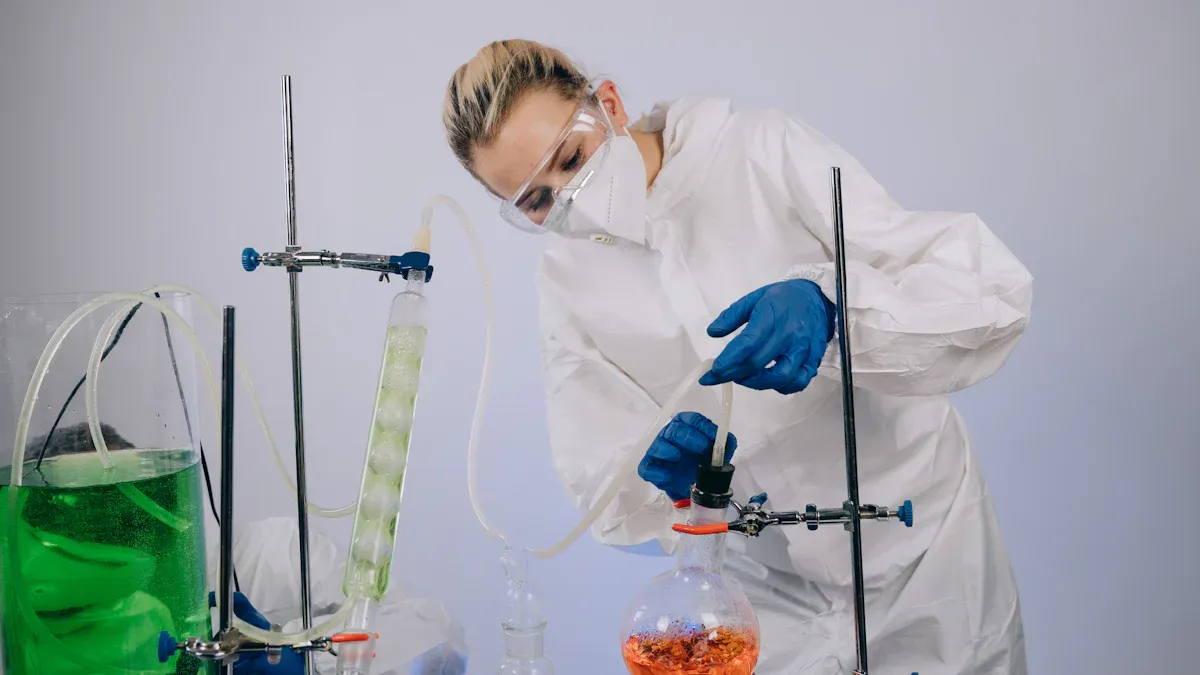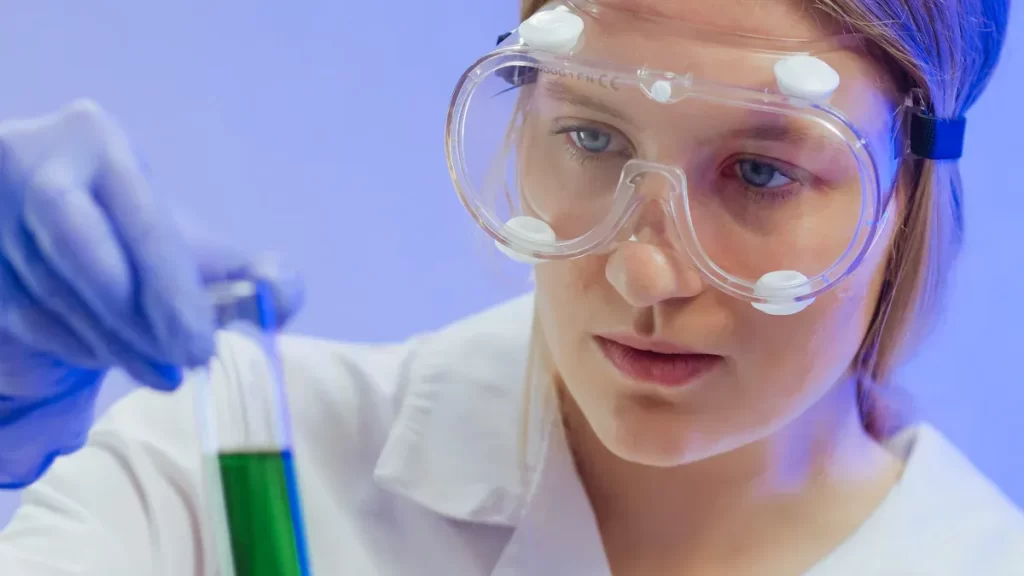News & Events
HCl SDS Safety Updates for Western Blot Labs 2025

Start your shift by checking the latest hcl sds guidelines for western blotting. You must wear protective gear every time you handle hydrochloric acid. Good ventilation keeps you safe from fumes. Proper handling prevents burns, eye damage, and breathing problems. Always follow updated safety rules to protect yourself and your team.
Key Takeaways
- Always wear protective gear when handling hydrochloric acid. This includes gloves, goggles, and a lab coat to prevent injuries.
- Review the safety data sheet (SDS) before using hydrochloric acid. This ensures you are aware of the latest safety guidelines and emergency procedures.
- Label all containers of hydrochloric acid clearly. Use proper labels that show the chemical name, concentration, and hazard warnings.
- Follow safe disposal protocols for hydrochloric acid waste. Neutralize the acid before disposal to protect the environment and avoid accidents.
- Train all staff on safe handling and emergency response for hydrochloric acid. Regular training keeps everyone informed and prepared.
HCl SDS 2025 Updates
Regulatory Changes
You must follow new rules for handling hydrochloric acid in western blotting labs. The 2025 hcl sds guidelines now require you to review the safety data sheet before each use. You need to check for updates on hazard classifications and emergency procedures. The latest regulations ask you to keep the safety data sheet in a place where everyone can see it. You should also make sure that all staff know how to read and understand the hcl sds. These changes help you stay safe and avoid accidents.
Exposure Limits
You need to watch your exposure to hydrochloric acid. The safety data sheet lists new limits for how much you can breathe in during your shift. You should use fume hoods and wear masks when working with hydrochloric solutions. If you smell strong fumes or feel irritation, you must leave the area and report it. The hcl sds now includes clear steps for monitoring air quality. You should check these steps often to keep your lab safe.
Labeling Rules
You must label every container of hydrochloric acid with the right information. The 2025 hcl sds guidelines follow strict rules. You need to use labels that meet OSHA and GHS standards. These labels help you see hazards and safety tips at a glance. The table below shows what you need on each label:
| Requirement | Description |
|---|---|
| Compliance | Compliant with OSHA Hazard Communication Standard 1910.1200 and aligned with GHS |
| Label Type | Must be on the immediate container of every hazardous chemical |
| Purpose | Provides a snapshot of hazards and protective information related to the chemical |
You should check labels before using any chemical in western blotting. If a label is missing or damaged, you must replace it right away.
Disposal Protocols
You must follow safe steps when you get rid of hydrochloric acid waste. The hcl sds gives you clear instructions for disposal. You should never pour concentrated acid down the drain. Instead, you need to neutralize it first. Here are best practices for disposal:
- Add concentrated acids to a large volume of an ice water solution of base (1:10 ratio) such as sodium carbonate, calcium hydroxide, or sodium hydroxide.
- Make sure the pH of the solution reaches between 5.5 and 9.0 before disposal down the drain, followed by 20 parts water.
- Conduct neutralizations in a fume hood with a safety shield to manage vapors and heat.
- Use appropriate personal protective equipment: lab coat, gloves, goggles, and a face shield.
- Keep the containers cool during the process, such as using a beaker in slushy ice.
- Proceed slowly during the neutralization process.
You must always check the safety data sheet for updates on disposal. These steps protect you and the environment from harm.
Safe Handling of Hydrochloric Acid

Preparation Steps
You must prepare hydrochloric acid solutions with care in western blotting labs. Always read the label on every container before you start. Use a clean glass beaker for mixing. Add acid to water slowly. Never add water to acid. This step prevents splashing and dangerous reactions. Keep your face away from the container. Wear gloves, goggles, and a lab coat. Work in a fume hood to avoid breathing in fumes.
Tip: Always check the container for the correct chemical name. Improper labeling can cause accidents. At UC Berkeley, a mislabeled container led to a chemical reaction and injury. You protect yourself and others by double-checking every label.
Avoid using metal containers or tools. Hydrochloric acid can react with metals and release harmful gases. Use only glass or plastic equipment. Keep organic materials away from your workspace. Clean up spills right away using neutralizing agents.
Steps for safe preparation:
- Gather all PPE and materials.
- Place the beaker in a fume hood.
- Pour water into the beaker first.
- Slowly add hydrochloric acid to the water.
- Stir gently with a glass rod.
- Label the solution clearly.
- Store the solution in a safe place.
Blot Workflow Use
You use hydrochloric acid in western blotting to adjust pH and clean equipment. Always follow the workflow steps to keep your lab safe. Before you start blotting, check that all containers have clear labels. Make sure your workspace is free from clutter. Set up your western blotting apparatus away from acids and bases.
During blotting, handle acid solutions with steady hands. Use pipettes or dispensers designed for acids. Never mix hydrochloric acid with unknown chemicals. If you spill acid during blotting, stop your work and clean the area right away. Alert your team if you notice strong fumes or irritation.
Schools have faced evacuations due to hydrochloric acid spills. In Maryland and Pennsylvania, spills led to closures and safety concerns. You prevent these incidents by following each step in your blot workflow and reporting any problems.
Waste Disposal
Dispose of hydrochloric acid waste with strict safety steps. Never pour acid down the drain without neutralizing it. Use a base like sodium carbonate to neutralize the acid. Check the pH of the solution. Make sure it falls between 5.5 and 9.0 before disposal. Pour the neutralized solution down the drain with plenty of water.
Wear gloves, goggles, and a lab coat during disposal. Use a fume hood to avoid breathing in vapors. Keep the waste container cool by placing it in ice. Label all waste containers with the contents and date. Store waste away from blotting equipment and other chemicals.
Note: Always follow your lab’s disposal protocol. Check the safety data sheet for updates before you dispose of any hydrochloric acid waste.
You keep your western blotting lab safe by following these steps. Careful preparation, proper workflow, and safe disposal protect you and your team from harm.
PPE for Western Blotting

Required Gear
You must wear the right personal protective equipment every time you handle hydrochloric acid in western blotting. The 2025 standards list several items you need for full protection. The table below shows the main gear and its purpose:
| Personal Protective Equipment (PPE) | Description |
|---|---|
| Chemical-resistant gloves | Protects hands from acid exposure |
| Safety goggles | Shields eyes from splashes |
| Face shields | Provides extra face protection |
| Protective clothing | Prevents skin contact with chemicals |
You also need to wear pants and closed-toe shoes. Boots give extra protection for your feet. A vapor respirator helps if you work in areas with acid fumes.
Best Practices
You keep yourself safe by following best practices for PPE. Always use acid-resistant gloves to stop skin contact. Put on goggles or a face shield to protect your eyes from splashes. Wear a full suit or lab coat to cover your skin. If you notice strong fumes, use a respirator and make sure the room has good ventilation. Never skip any part of your gear, even for quick tasks in western blotting.
Tip: Check your PPE before each use. Look for cracks, tears, or signs of wear. Replace any damaged gear right away.
Maintenance
You must inspect your PPE on a regular schedule. Set up a routine for checking gloves, goggles, and clothing. Write down your inspection process so everyone on your team knows what to do. Regular checks help you find problems before they cause injuries. Replace any PPE that looks worn or damaged. Clean your gear after each use to keep it in good shape.
Note: A strong inspection routine keeps your lab safe and helps you avoid accidents.
Emergency Response
Spill Actions
You must act fast if hydrochloric acid spills in your lab. First, alert everyone nearby. Move away from the spill area. Put on your PPE before you clean up. Use chemical spill kits designed for acids. Sprinkle neutralizing powder on the spill. Wait for the fizzing to stop. Scoop up the neutralized material with a plastic scoop. Place it in a labeled waste container.
Tip: Always keep spill kits in easy-to-reach places. Check them every month to make sure supplies are fresh.
If the spill touches your skin, wash the area with running water for at least 15 minutes. Remove contaminated clothing. If acid gets on the floor, block off the area until cleanup is complete.
Exposure Care
You must know what to do if hydrochloric acid touches your skin or eyes. For skin contact, rinse with water right away. Keep rinsing for 15 minutes. Do not use soap or creams. For eye exposure, use an eyewash station. Hold your eyelids open and flush your eyes for 15 minutes. Seek medical help after rinsing.
If you breathe in fumes, move to fresh air. Tell your supervisor. If you feel dizzy or have trouble breathing, call for medical help. Use a safety shower if large amounts of acid spill on your body.
| Exposure Type | Immediate Action | Next Step |
|---|---|---|
| Skin contact | Rinse with water 15 min | Remove clothing |
| Eye contact | Flush eyes 15 min | Get medical help |
| Inhalation | Go to fresh air | Seek medical help |
Reporting
You must report all acid spills and exposures. Fill out an incident report form. Write down what happened, who was involved, and what actions you took. Give the report to your safety officer. Keep a copy for your records.
Alert: Reporting helps your lab track safety problems and prevent future accidents.
Review your lab’s emergency response plan every year. Practice spill drills with your team. You keep everyone safe by following these steps and staying prepared.
Storage and Labeling (HCl SDS)
Storage Rules
You must store hydrochloric acid in a cool, dry, and well-ventilated area. Use a chemical storage cabinet made for acids. Keep the temperature below 25°C (77°F) to reduce the risk of fumes. Place containers on lower shelves to prevent spills from falling. Always close the cap tightly after each use. Store only the amount you need for your work. Do not keep large volumes in the lab.
Tip: Check the storage area every week. Look for leaks, corrosion, or broken containers. Report any problems to your safety officer right away.
Segregation
You need to keep hydrochloric acid away from incompatible chemicals. Never store it near bases, oxidizers, or organic materials. Mixing these can cause dangerous reactions. Use separate shelves or cabinets for acids and bases. Place a physical barrier, like a plastic tray, between different chemicals.
Common Incompatible Chemicals:
| Chemical Type | Example Substances |
|---|---|
| Bases | Sodium hydroxide, ammonia |
| Oxidizers | Hydrogen peroxide, bleach |
| Organics | Alcohols, acetone |
You protect yourself and your lab by following these segregation rules.
Labeling
You must label every hydrochloric acid container clearly. Use labels that meet OSHA and GHS standards. Each label should show:
- Chemical name (Hydrochloric Acid)
- Concentration (for example, 37%)
- Hazard pictograms (corrosive, irritant)
- Date received and date opened
- Your name or initials
Alert: Replace any label that is faded, damaged, or missing. Labels help you and your team identify hazards quickly.
Proper storage and labeling keep your western blotting lab safe and compliant with the latest HCl SDS guidelines.
Training and Records
Staff Training
You need to train every staff member who works with hydrochloric acid. Training helps you understand chemical hazards, safe handling, and emergency actions. You learn how to read Safety Data Sheets (SDS) and follow lab rules. You practice using personal protective equipment (PPE) and handling spills. You review the steps for mixing acids and disposing of waste. You also learn how to report accidents and exposures.
Tip: Schedule training before new staff start working in the lab. Repeat training every year to keep everyone up to date.
Checklist for HCl SDS Training Topics:
- Chemical hazards and risks
- Proper use of PPE
- Safe mixing and handling procedures
- Emergency response steps
- SDS reading and understanding
- Disposal protocols
- Reporting incidents
Documentation
You must keep records to show that your lab follows safety rules. Good documentation proves that you train staff and manage chemicals correctly. You need to update records when you add new chemicals or train new staff. You also need to keep SDSs where everyone can find them.
Here is a table showing the main types of documentation you need:
| Documentation Type | Description |
|---|---|
| Written Hazard Communication Program | Details chemical hazards, storage, labeling, and training at your site |
| Chemical Inventory List | Lists all chemicals that require SDSs, updated when new chemicals arrive |
| Proper Labels and Warnings | Shows that all containers have correct hazard labels |
| SDSs and Right-to-Know Access | Ensures staff can always access SDSs for chemicals they use |
| Training Records | Tracks employee training on hazardous chemicals and safety standards |
Note: Keep these records in a safe place. Update them often to stay compliant.
Annual Review
You need to review your training and records every year. This helps you find gaps and fix problems. You check that all staff have completed training. You make sure your chemical inventory matches what is in the lab. You confirm that all containers have proper labels. You also review your emergency plans and update them if needed.
📝 Annual reviews help you keep your lab safe and meet all legal requirements. Regular checks protect you and your team from accidents.
Research Applications
Western Blotting
You use western blotting to study protein detection in clinical research. This method helps you analyze protein extraction from female reproductive tissues. You follow a protocol that includes sodium dodecyl sulfate for sample preparation. You separate proteins by size and transfer them to a membrane for western blot analysis. You use chemiluminescence detection to visualize the results. Western blotting allows you to compare protein levels in different clinical samples. You rely on this protocol to study inflammation and disease in the reproductive system.
You often use hydrochloric acid during blot workflow steps. You adjust the pH of buffers and clean equipment. You must follow the protocol for safe handling and disposal. Western blot analysis helps you detect changes in cytokines linked to pelvic inflammatory disease. You use this technique to study clinical risks and treatment options for female patients. Western blotting gives you reliable data for clinical analysis and research.
Tip: Always check your protocol before starting western blotting. Accurate sample preparation and protein extraction improve your results.
Pelvic Inflammatory Disease
You study pelvic inflammatory disease to understand inflammation in the female reproductive system. Researchers use hydrochloric acid and lipopolysaccharide to create a clinical model of pelvic disease in mice. This protocol helps you analyze the effects of treatment on inflammation and cytokines. You measure proinflammatory cytokines like IL-1β, IL-6, and TNF-α in the uterus using western blot analysis.
| Evidence Description | Details |
|---|---|
| Model Development | Hydrochloric acid and LPS create a pelvic inflammatory disease model in mice. |
| Inflammatory Response | Hydrochloric acid increases proinflammatory cytokines in the uterus. |
| Neutrophil Infiltration | Mice show more neutrophil infiltration in the endometrium after treatment. |
You use western blotting to study protein detection and cytokines in clinical samples. This protocol helps you compare treatment options for pelvic disease. You analyze inflammation and reproductive health in female patients. Western blot analysis gives you data to improve clinical treatment and disease management.
Note: Accurate protocol and sample preparation help you study pelvic inflammatory disease and inflammation in the reproductive system.
You keep your lab safe when you follow the latest HCl SDS safety updates. You use PPE, check labels, and train your team every year. You protect yourself and others by handling hydrochloric acid with care in western blotting. You help your lab stay compliant and avoid accidents.
Review your protocols today. Proactive safety management gives you peace of mind and keeps your research on track.
FAQ
What PPE do you need for handling hydrochloric acid in western blot labs?
You need chemical-resistant gloves, safety goggles, a lab coat, pants, and closed-toe shoes. Use a face shield for extra protection. Always check your gear for damage before you start work.
How do you safely dispose of hydrochloric acid waste?
Neutralize the acid with a base like sodium carbonate. Check the pH to make sure it is between 5.5 and 9.0. Pour the neutralized solution down the drain with plenty of water. Always follow your lab’s disposal protocol.
What should you do if hydrochloric acid spills on your skin?
Rinse your skin with running water for at least 15 minutes. Remove any contaminated clothing. Seek medical help if you feel pain or irritation. Report the incident to your safety officer.
Why must you add acid to water, not water to acid?
Adding acid to water prevents splashing and dangerous reactions. If you add water to acid, the mixture can heat up quickly and cause burns or release harmful fumes. Always pour acid into water slowly.
Where should you store hydrochloric acid in the lab?
Store hydrochloric acid in a cool, dry, and well-ventilated cabinet made for acids. Keep it away from bases, oxidizers, and organic materials. Check containers weekly for leaks or damage.

